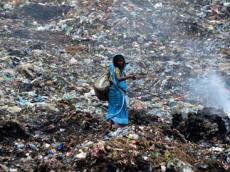|
|
TODAY.AZ / Weird / Interesting
Top 20 most polluted cities in the world - PHOTO
09 May 2014 [10:33] - TODAY.AZ
 Air quality in most cities that monitor their pollution levels exceed what the World Health Organization deems as safe.
Air quality in most cities that monitor their pollution levels exceed what the World Health Organization deems as safe.Delhi has the highest level of the airborne particulate matter, PM2.5 considered most harmful to health, with 153 micrograms. Not far behind is another Indian city, Patna with 149 micrograms. These figures are six times what the WHO considers a "safe" limit -- which is 25 micrograms.
Half of the top 20 cities in the world with the highest levels of PM2.5 were in India, according to the pollution data released by the WHO, which included 1,600 cities. Other cities with high levels were located in Pakistan and Bangladesh.
PM2.5 refers to the diameter measured in microns of particulates such as ammonia, carbon, nitrates and sulfate -- which are small enough to pass into the bloodstream and cause diseases such as emphysema and cancer.
The WHO data echoes an earlier study this year which found that air pollution in New Delhi is now worse than Beijing.
No Chinese cities ranked in the top 20 most polluted cities, despite thick, gray smog filling its cities and millions of residents commuting behind surgical masks. Beijing reported 56 micrograms of PM2.5. This year, Chinese leaders have declared "war on pollution."
Delhi has been described as having weak enforcement of pollution controls by India's Center for Science and Environment, a public interest group.
"Originally designed as compact entities to reduce the length of travel ... (Indian cities) are becoming victims of killer pollution, congestion ... and a crippling car-dependent infrastructure," according to the group.
Air pollution has spread by increasing reliance on fossil fuels, coal-fired power plants, cars and the use of biomass for cooking and heating.
Cities with the lowest level of pollution were located in Canada, the United States, Finland, Iceland and Sweden.
/CNN/
URL: http://www.today.az/news/interesting/133469.html
 Print version
Print version
Views: 3018
Connect with us. Get latest news and updates.
See Also
- 19 February 2025 [22:20]
Visa and Mastercard can return to Russia, but with restrictions - 05 February 2025 [19:41]
Japan plans to negotiate with Trump to increase LNG imports from United States - 23 January 2025 [23:20]
Dubai once again named cleanest city in the world - 06 December 2024 [22:20]
Are scented candles harmful to health? - 23 November 2024 [14:11]
Magnitude 4.5 earthquake hits Azerbaijan's Lachin - 20 November 2024 [23:30]
Launch vehicle with prototype of Starship made its sixth test flight - 27 October 2024 [09:00]
Fuel prices expected to rise in Sweden - 24 October 2024 [19:14]
Turkiye strikes terror targets in Iraq and Syria - 23 October 2024 [23:46]
Kazakhstan supplied almost entire volume of oil planned for 2024 to Germany in 9 months - 23 October 2024 [22:17]
Taiwan reported passage of Chinese Navy aircraft carrier near island
Most Popular
 Pakistan’s expanding defence partnerships put Azerbaijan in strategic spotlight
Pakistan’s expanding defence partnerships put Azerbaijan in strategic spotlight
 US Embassy commemorates anniversary of Azal plane crash
US Embassy commemorates anniversary of Azal plane crash
 Baku ask world uncomfortable questions. We are waiting for response
Baku ask world uncomfortable questions. We are waiting for response
 President Ilham Aliyev makes post on anniversary of AZAL plane crash
President Ilham Aliyev makes post on anniversary of AZAL plane crash
 Xiaomi introduces the 17 Ultra smartphone
Xiaomi introduces the 17 Ultra smartphone
 Student Loan Fund announces partial forgiveness for 2,360 graduates
Student Loan Fund announces partial forgiveness for 2,360 graduates
 VP Y?lmaz highlights economic, security, climate agenda amid regional cooperation move
VP Y?lmaz highlights economic, security, climate agenda amid regional cooperation move

